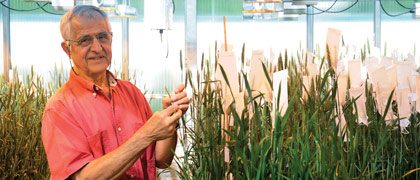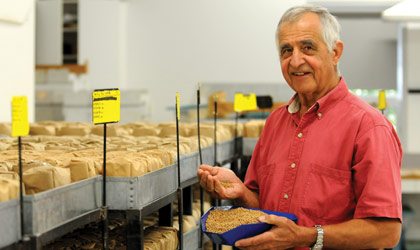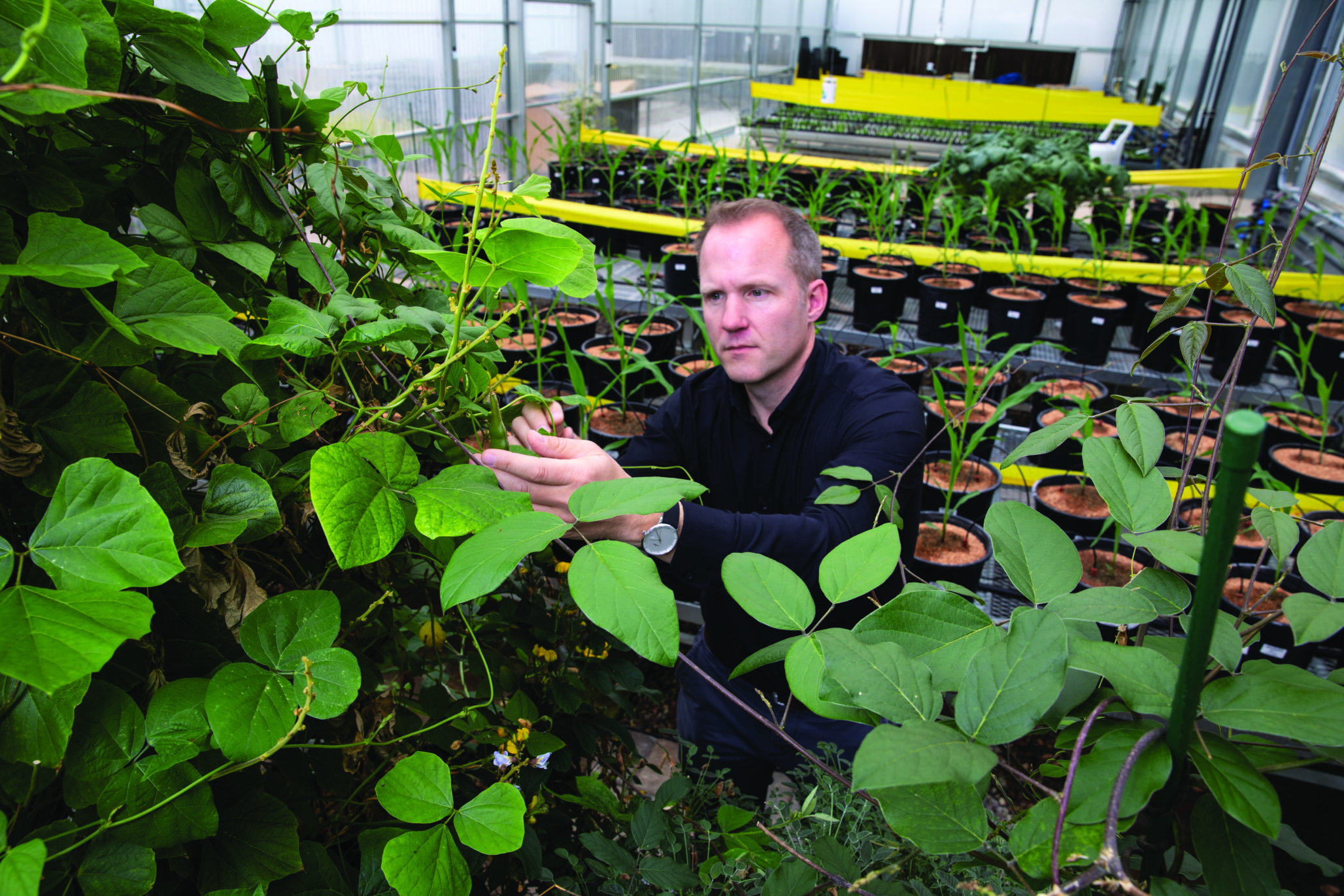
It’s more than a job. For Ron DePauw, breeding wheat and playing a role in the creation of a safe, wholesome and affordable food supply is a passion — some might even say a way of life.
When others said it couldn’t be done, Agriculture and Agri-Food Canada’s Ron DePauw of Swift Current proved them wrong.
For a long time, it was believed that pre-harvest sprouting resistance couldn’t be bred into white wheat. “Together, with my colleagues, we broke that hypothesis,” says wheat breeder Ron DePauw, who’s been working for Agriculture and Agri-Food Canada since 1973, first in Beaverlodge, Alta., and today in Swift Current, Sask.
But DePauw and his team didn’t just do this one time; they did it three times. It was thought that fusarium head blight resistance could only exist in a tall plant — that’s what the experts preached, DePauw says. Then, in 2009, he and his team released a semi-dwarf with semi-resistance.
Additionally, the negative correlation between grain yield and protein content was common knowledge. But DePauw and his team were determined to show that it didn’t have to be that way. “We got access to near infrared technology, which allowed us to non-destructively measure the protein content,” he says. “We selected plants for grain yield and protein and ended up selecting a better plant. We didn’t break the correlation, but we certainly shifted it. We made higher yielding wheat with a higher or similar protein content.”
The 2014 Canadian Plant Breeding and Genetics Award honoured Ron DePauw of Swift Current, Sask.
The variety AC Barrie, a hard red spring wheat, represented a major yield increase, while maintaining a high protein content required for baking quality. Grown on more than 41 million acres, AC Barrie was the most widely grown HRSW from 1998 to 2005. AC Barrie represented a paradigm shift in the cultivars available. Others that have come along since have followed suit.
These achievements didn’t just come about. They require work and lots of it. Those who know DePauw describe him as tenacious. The 70-year-old man works six days a week, arriving at the office each morning by 7 a.m. On any given day, one might find him in the field, a greenhouse, laboratory or in the office. He drives home to have lunch with his wife Elsa Marie each day and then returns to work where he focuses his efforts on improving wheat for farmers, bakers and ultimately consumers until 6 p.m., except for Fridays and Saturdays when he takes off at 5 p.m.
“I’m highly organized, goal-oriented and focused,” DePauw says. His dedication and work has resulted in the development and registration of 57 cultivars of wheat and six cultivars of triticale. For the past 17 years, 40 to 55 per cent of all the wheat grown in Canada derives from cultivars he and his team developed. That’s why DePauw is the recipient of 2014 Canadian Plant Breeding and Genetics Award.
Given the by the Canadian Seed Trade Association, the award is the highest honour for plant breeding. “It’s an award given by peers and I think that means a great deal,” says Patty Townsend, CSTA chief executive officer. “Ron is the No. 1 plant breeder in Canada right now and you can’t underestimate the contribution that he’s made at this point in his career.”
His contributions are even noticed outside of the seed industry. In 1991, DePauw received the Saskatchewan Order of Merit. Then, in 1994, he was made a Fellow of the Agricultural Institute of Canada. In 2003, he became a Member of the Order of Canada. DePauw has received numerous other awards, including an Honorary Doctor of Science from the University of Saskatchewan in 2012.
According to CSTA, the incremental value of grain produced from DePauw’s wheat cultivars exceeds a billion dollars. That’s why CSTA has dubbed him the “billion dollar man.”
But DePauw doesn’t work for awards. “I’ve always wanted to make top drawer cultivars that are profitable for farmers, safe and nutritious for consumers, and that contribute to the wealth of the nation,” he says. “It’s very humbling to receive this kind of recognition for doing something I enjoy.”
Having spent a lifetime working to advance wheat cultivars and varieties, Ron DePauw of Agriculture and Agri-Food Canada takes time to enjoy the little things in life, such as Judo and choreographed ballroom dancing with his wife Elsa Marie.
Early Start
As a member of his 4-H seed club in Southern Manitoba, DePauw began receiving the latest varieties to grow out for his crop project. “Since then, I’ve always had an interest in the newest varieties,” he says.
After high school, DePauw left Trehere, Man., to pursue his undergraduate work in the areas of science at the University of Manitoba and then philosophy and botany at St. Louis University in Missouri. In 1970, after completing his master’s degree, DePauw’s work took him to a plant breeding station in Njoro, Kenya, where he worked on a project administered by the University of Manitoba and funded by the Canadian International Development Agency. It was here that he met his wife, who happened to be visiting Njoro as part of a mission trip from northern Kenya.
But it wasn’t until DePauw enrolled in a genetics class during his graduate work back at the University of Manitoba that the sparks began to fly.
“I became totally fascinated,” DePauw says, noting that he’s always had an extensive curiosity about nature, plants and animals. “There’s tremendous diversity but you can see patterns or similarities of traits. I’ve always been fascinated by what’s behind this and knew there had to be something. And eugenics brought all the pieces of the puzzle together.” DePauw explains that the Greek word for good is “eu” and that eugenics is the deliberate making of genetic combinations to get a positive good.
In 1973, DePauw earned his doctorate in genetics and plant pathology from the University of Manitoba. He’s been working to improve wheat cultivars ever since. Being outdoors with the plants and making the selections is extremely rewarding, but DePauw also says it’s extremely tiring. “You’ve got the rubber boots sticking in the soil and mosquitos to deal with on top of the weather,” he says. “But when you can see the genetic variations and select what will work in farmers’ fields, it’s rewarding and exhilarating to know there’s the potential to make something better than what’s already out there.”
Through the years, DePauw says that industry and stakeholders have learned that genetics work. “We have incredible opportunities in being able to reduce the business risks for producers and processors,” he says. “We’ve really developed the capacity to collect plant breeding information and market intelligence — to know what is required by the market and then be able to find that needle in the hay stack.”
Today, DePauw focuses on making plants more nutrient efficient, especially in the areas of nitrogen, phosphorus and water. “Right now the nitrogen use efficiency of wheat you put in the ground runs about 30 to 45 per cent,” he says. “So if you put on 1,000 pounds of nitrogen, which is expensive, current wheat varieties only use 350 to 400 pounds. The rest is gone. If we could increase nitrogen efficiency to 40 to 50 per cent, we would make a huge gain, and I think we can do better than that.”
DePauw also stresses the importance of phosphorus to plant growth. “We only have about 25 years of readily extractable phosphorus,” he says. “And then we have another 25 years of difficult to extract phosphorus. After that, we have a problem.”
Achieving these goals is going to take a collaborative effort. While DePauw works to increase nitrogen and phosphorus efficiency, he stresses it really needs to be a team effort — that public and private institutions need to come together and work on these issues.
Advocating for Science
One of the things that frustrates DePauw is all the misinformation out in the public domain. For example, DePauw says the book “Wheat Belly” by Dr. William Davis accuses plant breeders of changing wheat. So what’s DePauw doing about it. For several years, he’s been growing out red fife and several of the original primitive wheat varieties and comparing it to the descendants of red fife. As a part of this project, DePauw has been working with a cereal chemist, Nancy Edwards, and a nutritionist, Dr. Nancy Ames.
“This is our third year on the project and we can’t find any differences in the amino acid, chemical, mineral or vitamin content,” he says. “This is a case where someone made an accusation where there was no science behind it.” DePauw is careful to acknowledge that there is gluten intolerance and celiac disease. However, these don’t mean wheat is bad, he explains.
As for the future, DePauw believes its extremely bright. “With the world population increasing to more than 9 billion people by 2050, that’s a lot of extra demand,” he says. “Right now about 1 billion people (one in seven) are in a food deficit situation. Things need to be done at a global level to bring these people into the economic sphere so they can purchase food.”
He says climate change will have a negative impact on agricultural production, but notes that Canada might experience some improvements. “There’s a greater opportunity for Canada to contribute to the food supply and food security,” DePauw says. “But this food has to be able to be purchased and we have to be able to get it to the market.”
DePauw is excited about the next frontier where plant breeders can more easily use molecular markers, which are linked to high-value genes. “There will be more and the costs will come down,” he says. “We’ll also know which regions are less detrimental.” He believes genomic technology will continue to expand, accelerating the pace and accuracy in making better selections at all stages. However, DePauw says the need for nurseries and field trials won’t go away.
“We’ll be applying new tools, but still have the old tools, too,” DePauw says. “Genomics is just another tool — more sophisticated. My research has no value unless it contributes to safe, wholesome and nutritional food; otherwise, it won’t be profitable for farmers. You have to think of it in its entirety.”
Julie Deering













